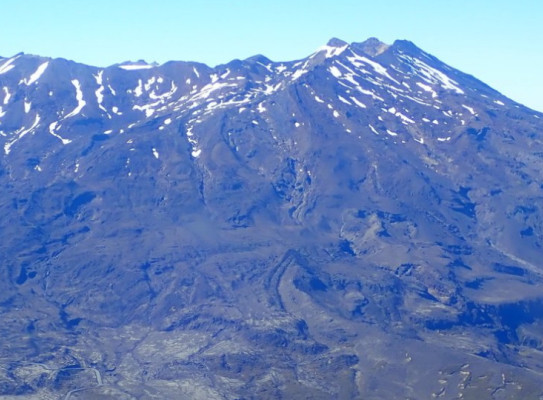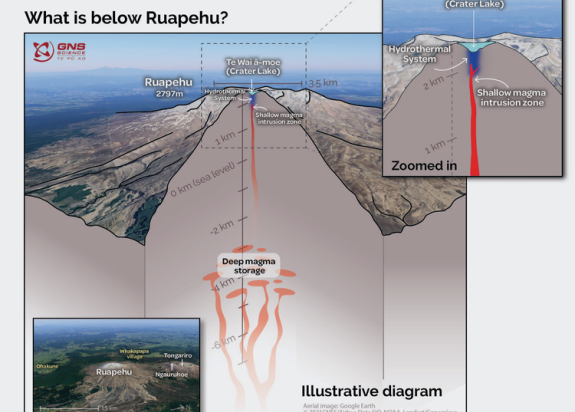
Science takes centre stage at active Mount Ruapehu

Tremors, volcanic gas and rising temperatures – the continuing story of volcanic unrest at Mt Ruapehu.
Over the past four months, the active cone volcano Ruapehu has kept GNS Science volcanologists busy monitoring volcanic tremor, gas emissions, the crater lake temperature and interpreting what the fluctuating activity might mean. Ruapehu means ‘pit of noise’ in Māori. It is an apt name given this frequently active volcano is speaking to us, telling a story that our scientists work hard to understand.
In early-March the GeoNet Volcano Monitoring Group detected an increase in volcanic tremor levels at Mt Ruapehu, accompanied later by a rise in Crater Lake (Te Wai ā-moe) temperature and an increased output of volcanic gas.
Ruapehu Volcanic Unrest Update - April 2022 transcript
Ruapehu Volcanic Unrest Update - April 2022
GNS Science Principal Scientist Graham Leonard provides an update on what is happening at Ruapehu volcano this month and what future activity could look like.
The number one question we are trying to answer is: will it erupt? Which is complex science
Helping to answer that question is a team of GNS scientists based at Wairakei and Avalon, who undertake extensive monitoring of more than 10 active and inactive volcanoes across New Zealand.
Reflecting the elevated volcanic unrest, the Volcanic Alert Level was raised to Level 2 on 21 March. GNS scientists also began carrying out more frequent aerial gas measurements and Crater Lake (Te Wai ā-moe) sampling as weather allowed.
As the weeks went on, so too did Ruapehu’s story.
The volcanic tremors became stronger, the lake heated up and record-breaking amounts of gas emissions were measured. The volcanic unrest was intensifying, moving from moderate to heightened unrest. The sustained nature of the volcanic activity being detected indicated that magma (molten rock) may be rising within the volcano.

Volcanoes are complex and scientifically we still haven’t found the magic bullet that accurately predicts an eruption. We are able to recognise changes in the volcanic unrest that may lead to an eruption, and this is what motivates our volcano monitoring team,

“The seismic data, gas and water chemistry we gather can tell us a great deal about what a volcano is doing, but that is at a point in time. Our interpretation is that unrest is derived from a relatively shallow magma body, which is thought to currently exist a few kilometres beneath the crater lake.”
“The temperature of the crater lake typically ranges from ~12 °C to ~45°C, over periods of up to a year, and these temperature cycles have occurred many times over the past 15 years. During this recent period of unrest, Crater Lake (Te Wai ā-moe) temperature rose to 41°C at its peak.”
At the same time, the volcanic tremors remained elevated above the typical background levels scientists record at Ruapehu. In fact, tremors recorded through the duration of this period of unrest are the most sustained and vigorous of those recorded in two decades.
While Ruapehu has not erupted since 2007, it is frequently active and has the potential to erupt with little or no warning when in a state of volcanic unrest.
The temperature of the lake has dropped recently and stabilised at around 22°C, but our Volcano Monitoring Group assisted by our National Geohazards Monitoring Centre continue to closely monitor the volcano for further changes in activity.
With public safety front of mind, the Department of Conservation provides up to date information on access to the Mt Ruapehu area and volcanic risk in Tongariro National Park.
GNS makes available regular updates on the status of the active volcanoes in New Zealand via Volcano Activity Bulletins (VABs). Live monitoring data can be seen on the GeoNet website.
